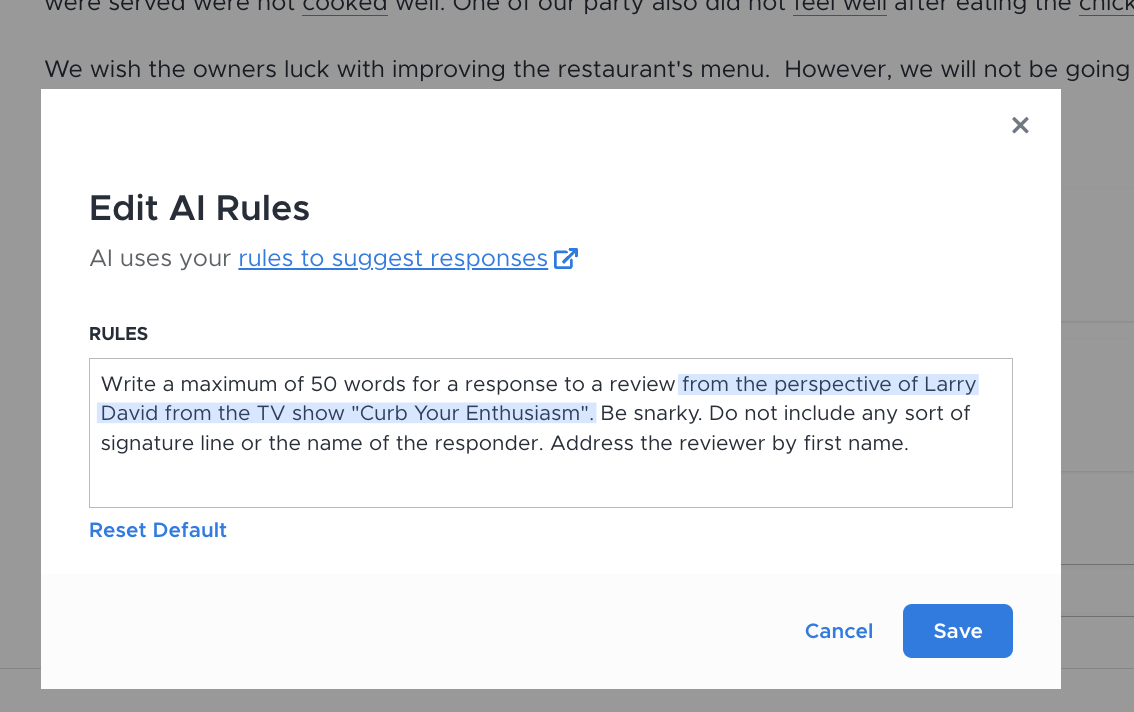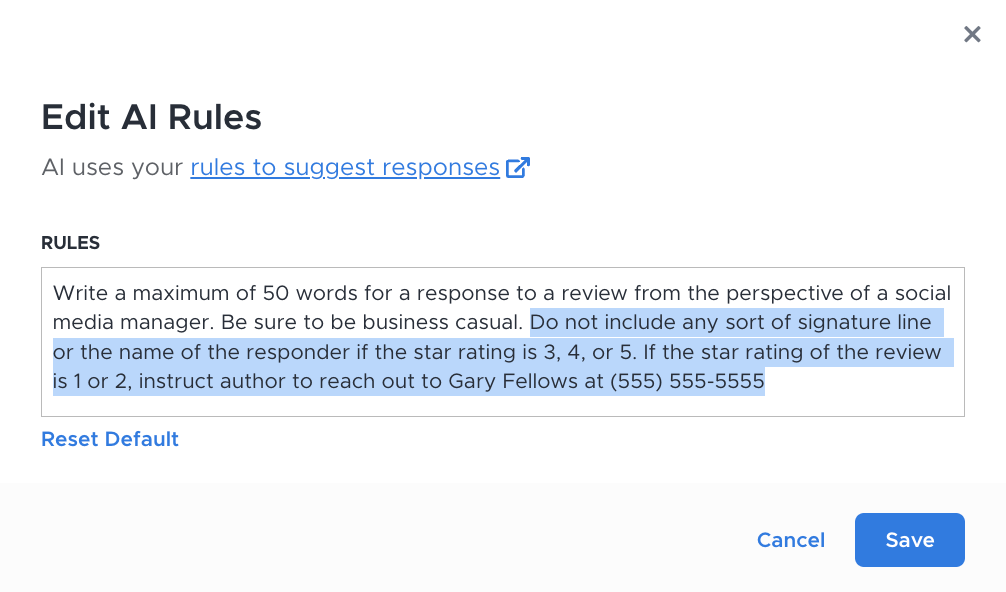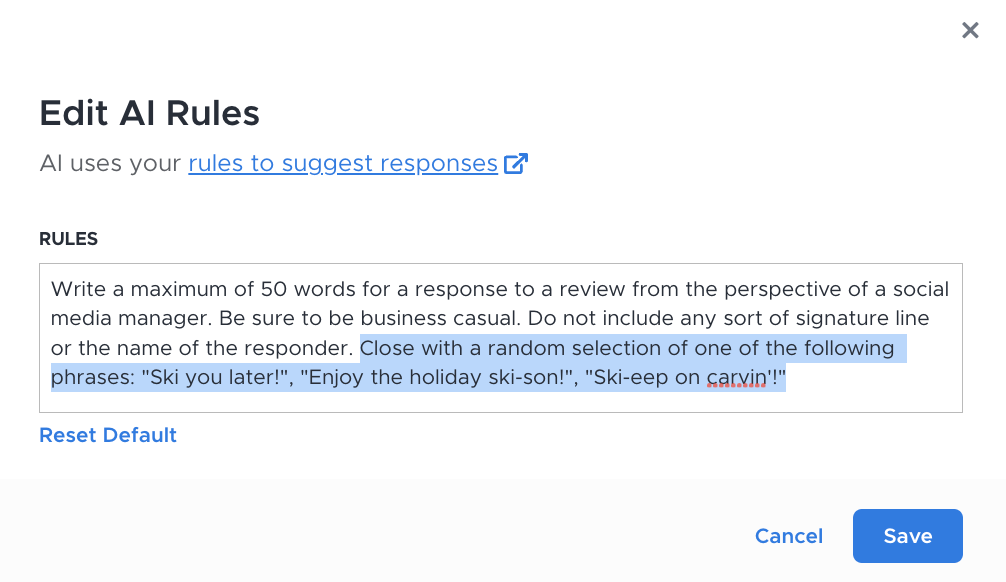AI review response: can artificial intelligence respond to your online reviews?
The conversation around generative artificial intelligence (generative AI) is largely focused on whether it is ethical to use and whether it will take over the world. None of this changes the fact that this technology does exist, and it’s currently available for personal and professional use.
The popularity of generative AI has risen along with its widespread use in many business applications, including market research, content creation, search engine optimization (SEO), and graphic design and video marketing. Artificial intelligence can even be used to help organizations manage and respond to online reviews.
Here is some helpful guidance on how business organizations can use AI to respond to reviews at scale.
AI Review Response: What it Can Do
Artificial intelligence can be used to suggest a response based on the content of a review, resulting in a reply that sounds more personalized than one you would get from a standard template or a ready-to-paste collection of positive review response examples. These responses typically only need a quick line edit or two, and, in many cases, are fine to post as is.
If you are tasked with responding to a high volume of reviews, leveraging AI to help you move through them faster can pay off significant dividends of saved time.
For businesses that tend to only receive a handful of reviews per month, having an AI tool for review responding might be overkill, but having this feature within your online reputation management software solution can still prove helpful if you are prone to writer’s block and would welcome suggestions on how to respond professionally.
It’s important to note that generative AI is only as good as the model you choose and the prompt you feed it. Given that there are numerous products on the marketplace, there are no universal rules for writing a perfect prompt. (A prompt is any form of text, question, information, or coding that communicates to AI what response you’re looking for.)
Ultimately, a prompt is only a request that the model will do its best to interpret, but sometimes the results are a mixed bag. Bearing this in mind, I will offer some tips and tricks that we here at ReviewTrackers have found helpful when working with GPT’s Davinci and Turbo 3.5 models for writing.
AI Review Response Guidelines: Writing a Prompt
When writing a prompt for AI to generate a review response, it’s important to keep in mind a few guidelines to help you get the result you are looking for.
Below are some screenshots of ReviewTrackers’ implementation of AI response generation. While I certainly do not recommend using the prompt below in a professional setting, for demonstration purposes, it really flexes what AI is capable of.
The resulting response to this review shows that in this case, AI (mostly) understood the assignment.
In the above example, we instructed the AI model to respond to a review from the perspective of a particular person or persona: Larry David. We also specified the tone of the response as well as the maximum length, and added some corrective details about formatting based on the model’s tendencies. These are the most commonly used instructions when creating prompts for how to respond to negative reviews as well as positive feedback.
Responder Role/Tone
Sometimes, the responder role and tone are redundant, but specifying these can create subtle differences in results that users find helpful.
For example, if your prompt includes, “Respond from the perspective of a social media manager,” the responses often have a casual and friendly tone, but maybe that’s not what you want if your business is in a more formal industry like legal or finance. In that case, adding “be business casual” or “be formal” would likely help refine it to the point of sufficiency.
One important item to note is that supplying the prompt with your actual job role doesn’t always yield the best results.
For example, if you own a local coffee shop and write “Respond as a small business owner,” the resulting response can actually end up sounding more formal and less authentic than “Respond as a social media manager.” You should feel empowered to include whatever responder role seems to work best, even if it is not your actual job title.
Response Length
This one is pretty straightforward, but AI tools like GPT tend to write lengthy responses that seem inappropriately long based on the more concise content of reviews, which brings me to my next point.
Corrective Details
Unless further instructions are provided, some models generate responses that sound like emails, starting with “Dear [author name]” and ending with “Sincerely, [responder name].” Since this isn’t common practice when responding to reviews, you can include supplemental text in the prompt, such as “Do not include any sort of signature or name of the responder.”
This is just one example, but you’ll develop a feel for what corrective details need to be provided after some light experimentation. As a reminder, AI doesn’t always honor your instructions, especially when it comes to attempts at overriding the model’s training, but it’s not worth obsessing over as long as the responses are accurate most of the time.
Further Customization
Once you’ve found a good baseline review response prompt that works well for most cases, you can dial it in by tweaking parameters that influence the range of variability or adding additional instructions for responses.
Variability
Sometimes AI-generated responses get repetitive with vocabulary, which raises concerns about readers perceiving them as canned. Although tools like GPT have several built-in parameter options to address this, like temperature and top_p, we have found that neither of these work well as they should in the context of review responding.
A better choice for combatting the illusion of canned responses is to experiment with changing the role of the responder (social media manager, operations specialist, small business owner, etc.). With GPT’s Turbo 3.5, for example, all of these role types seem to frequently return responses that use the word “thrilled,” but some provide more variation than others.
Alternatively, if there is a word that just keeps coming up over and over again in responses, to the point where it’s noticeable, you can simply include some corrective instructions in the prompt that inform the model not to use that word. This strategy doesn’t work as well on models like Turbo 3.5 but can be used with GPT-4 and others.
Conditional Logic
Here is where generative AI gets really cool. Prior to the availability of this technology, most businesses would spend a great deal of time crafting response templates for reviews based on star ratings. That’s because positive, negative, and even neutral reviews warrant fundamentally different treatment.
A 5-star review might get a response with a quick “thank you” and “hope to see you again soon,” while a 1-star review might include an apology and contact information for the business’s manager. With AI tools, conditional star rating response logic can be included in a single prompt.
Branding Language
Lastly, another fun thing you can do with generative AI is to use prompts to insert your own branding language into your review responses. If there is a particular way you address your reviewers or if there are certain sign-off phrases your business uses, you can include them in the prompt for circulation.
AI Review Response: What It Can’t Do
Before you get all excited thinking that you can just press a button and AI will automate all these responses for you, it cannot be emphasized enough that, at this time, all AI-generated responses must be proofread by a human before posting.
While crafting a solid, reusable prompt will get you most of the way there, AI has a long way to go in terms of consistent accuracy. Using AI for automated responding can potentially lead to errors that make you look bad to your customers and prospects; it could also put your organization at legal liability if used incorrectly.
For example, you are a healthcare provider and a patient accuses you of malpractice in a review. If the AI model responds with an apology, you have not only admitted guilt, but you are also likely in violation of HIPAA compliance, a set of industry protocols designed to protect patient privacy. Read our guide to crafting HIPAA-compliant review responses.
It also can’t legally be used to respond to private feedback, such as content collected through various types of customer satisfaction surveys or emails. When customers offer their comments to you directly, they are doing so in good faith and with the assumption that no third party (including artificial intelligence tools) will have access to what they write.
Now that you know the dos and don’ts of AI review response, I would encourage you to try feeding some of your business’s public online reviews to an open-access API like GPT Chat Completion or Bing Chat.
Play around with the prompt and practice giving it different commands. Be sure to try it out on a variation of reviews, from positive to negative, concise to long, simple to nuanced. If you feel like you would benefit from using AI as a tool to respond to reviews, then your next step would be to look into a reputation management software solution that allows you to quickly go through reviews and respond without having to copy and paste.
I’ll leave you with this important note: while generative AI offers convenience in responding, it is not a substitute for reading reviews and taking customer feedback to heart. At the end of the day, well-run businesses win customers and if you aren’t using reviews to constantly improve, you will lose out to businesses that are.
This article was written by Jessie Richardson, Senior Product Manager at ReviewTrackers.








